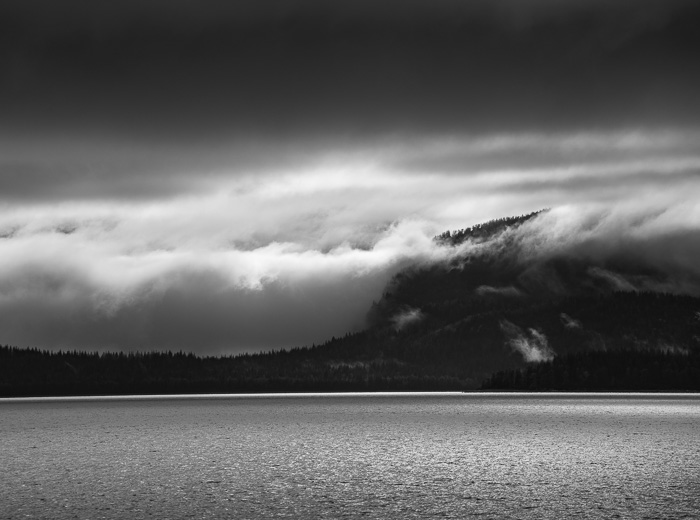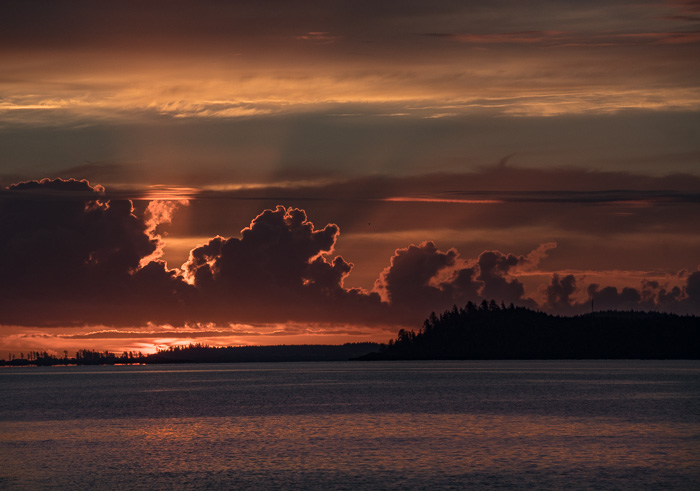This is a continuation of a report on a trip with the Sony a7RII. The series starts here.
I ended up using ISO 100 and ISO 800 for virtually all my exposures on the Alaska trip. Since the a7RII is fairly ISOless from ISO 100 through ISO 500, there is little reason to use ISO settings 125 through 500; you’ll get pretty much the same shadow noise shooting at ISO 100 and pushing in post, and, if you do that, you’ll have a lower probability of clipping highlights. At ISO 640, the a7RII changes its conversion gain, and exhibits lower noise, so there are advantages in using that ISO setting over ISO 100 and a 2 2/3 stop push in post. After that, the a7RII returns to ISOless behavior, so there is negligible shadow improvement to be had from cranking up the ISO setting, and the same highlight advantages pertain. After a certain point, as the light drops, the finder image will become unusable and you might well exceed Lightroom’s pushing capability, but I never encountered light that dim on the trip, since I slept through the Aurora Borealis display the only night we had one.
“Why ISO 800?” I hear you asking. “Why not ISO 640, since that’s all that’s needed?” The answer lies in the way the a7RII’s controls operate. With the camera’s controls set to their defaults, pressing the right side of the back wheel allows you to change ISO, and rotating the back thumbwheel lets you change the setting in whole -stop increments, rather than the third-stop increments of the back wheel. So, to get from ISO 100 to ISO 800 is a matter of one press of the back wheel and three clicks of the thumbwheel. Same for getting from ISO 800 to 100 100. ISO 800 is close enough to ISO 640 for my purposes.
For most situations, I like using aperture exposure mode, and multi-metering. I don’t use the meter as the final arbiter of exposure, but using it with active use of the exposure compensation control allows convenient adaptation to rapid changes in lighting. Also, since the exposure control is just about the only direct adjustment on the camera, using it lets you see its setting at a glance.
How do I decide on the exposure? If the bright parts of the subject are fairly neutral in color, I use the live (luminance) histogram, supplemented by occasional taps at the playback button and observation of the three-channel histogram and looking for blinkies. I have been experimenting with turning zebras on at a setting of 95%, but I haven’t developed confidence in that method yet. I tweak the exposure compensation dial to get the histogram I want.
On the trip. this technique served me well with a few exceptions.
The first is the obvious one; the darkest setting on the Sony a7x exposure compensation dial is -3 stops, and that’s just not enough for shooting into the sun with small areas of the picture composed of clouds and water, and large amounts of dark trees. When that happens, there are two things I do. If it’s only going to be a couple of shots for which I have to deal with the problem, I’ll change the field of view to include more bright elements, press down the exposure lock button, and recompose. If I’m going to be making more than a handful of exposures, I’ll switch to manual exposure mode.
I wish that the range of the exposure compensation control were from +2 to -4, rather than plus and minus three stops. I have never found a situation where I needed +2, let alone +3.
Another situation that causes trouble – it caught me once on the trip – is one or two isolated very bright areas. The live histogram window on the a7x cameras doesn’t go all the way to the right-hand side of the EVF; there is a little bit of the preview image to the right of the histogram. If that part of the preview image is fairly light, you can’t clearly see the right-hand bucket of the histogram. Normally things kind of tail off at the top of the histogram, but sometimes there’s a spike on the right with unpopulated buckets to the left of it. Most of the time, that’s OK, too, since the right hand bucket is measuring specular highlights, which are usually best clipped.
Here’s how I got caught out. I was shooting a calving glacier from a Zodiac, kneeling on the floor with my elbows on the tube, looking into the sun with the WATE, trying to get the sun and its reflection In the icy sea. If the sky had been clear I wouldn’t have had a problem, but it was hazy, causing the sun’s light to spread out. In my awkward position, I didn’t take the time to check the three-color histogram or look for blinkies. That was an error. The resultant images had blown areas extending irregularly out from the sun, damaging the image. Had I known, I would have switched to manual mode and made the exposure very short, making the blown areas smaller.
Here is the result of double development in Lr, followed by a lot of masked blending and masked curves:
It still looks fake. It will take some more work, possibly with the aid of an HDR program.
In case it wasn’t clear at the beginning, let’s go over how I managed the ISO “knob” on this trip. The default setting was ISO 100. If there wasn’t enough light for ETTR at ISO 100, I set the aperture to what I wanted and cranked the exposure compensation dial in the negative direction to obtain an acceptable shutter speed. As the light fell, when the dial got to -3, if the highlights had plenty of room, I changed the ISO to 800 and did the same thing at that ISO. Pretty simple, huh?
Some have objected to the variable “underexposure” technique that I recommend for ISOless cameras from the perspective that it requires individual adjustments of the Exposure slider in Lightroom for each picture. I usually say something like, “So?” However, for those for whom adjusting exposure in post for each and every image is a terrible privation, here’s a suggestion to Adobe for a future option in Lightroom: look at the exposure compensation setting in the EXIF data, and compensate the Exposure accordingly.





Hi Jim,
I’ve read this and other posts of yours with interest. I’ve got an a7rII and have been doing tests of my own to try and figure this camera out. I understand what you are saying about ISOless behaviour and the change at 640. However, in my test shots, comparing ISO 400 to ISO 100 (as you did, same A/SS and pushing the ISO 100 shot in LR), and the ISO 100 shot has colour/noise issues, especially noticeable if the shadows are pushed to +100. This was with a particularly high DR scene. Looking at your bookshelf images, I know you haven’t used 400 (or 500) as a base (not in the post I was looking at anyway), but the 100 image looks worse than the 400 image. Have you done tests specifically between 400/500 and 100?
Are you using Lr?
Yes, using LR, Adobe Standard profile. Also tried Capture One, as that seemed to produce better results for my long exposure tests, and still got some differences between 100 and 400 ISO tests, I didn’t study these ones as much as the LR ones though.
Jim,
Have you come to the conclusion that it’s just easier to take a Nikon D810 into this journey/environment ? It’s just more reliable across the board and any mistakes you make are mitigated by Nikon’s dynamic range. For me it comes down to whether I want to spend my remaining hours on this planet fixing Sony’s shortcomings in post or whether I’d like to get out there and take more photos. It’s safe to say that I sometimes spent more than an hour on certain Sony photos and never was able to get them to my satisfaction. Most NEF files take a few quick adjustments and I’m done in 3-5 minutes.
Max, I find the advantages of the a7RII over the D810 compelling for this kind of trip:
Lighter
Live histogram/Zebras (I’m beginning to love the zebras)
Better DR over ISO 500
A few better native AF lenses: Zony 35, Zony 55, Sony 90/4
Ability to use the WATE, perhaps the best SWA zoom there is
IBIS
EFCS without a double push, which means you can use it essentially all the time
And that’s just a few off the top of my head.
Jim
What is EFCS without a double push? Great article!!!!
On the D810, it takes two depressions of the shutter release for every EFCS shot.
You could gain more distance with the exposure dial if you use HDR continuous shooting. An example would be to setup 3.0EV3 spacing and then use the Exposure Dial on top and set it on -2EV. The result in this example would be 3 images +1, -2 and -5EV. I agree though, not as clean as having the dial control to -5 to +5.
Using this method you can even get exposure compensation beyond -5 or +5.
If you set DISP Button>Monitor and check the box “For Viewfinder” it’s nicely illustrated on the exposure bar in that view.
I don’t find zebras useful from 70-100, in that range it doesn’t tell me what I need to do with the exposure unless I’m using 80 for face exposure.. If I use 100+ then zebras appear in an area that is potentially blown. I can use them to adjust exposure. Another nice feature is that 100+ is equal to blinkies (the one’s that appear with the playback button and 3 histogram) so I get a live view of blinkies.
Incidentally, I’ve found zebras at 100+ can be recovered with the highlights slider, to a degree, so not all is lost.
In case it wasn’t clear at the beginning, let’s go over how I managed the ISO “knob” on this trip. The default setting was ISO 100. If there wasn’t enough light for ETTR at ISO 100, I set the aperture to what I wanted and cranked the exposure compensation dial in the negative direction to obtain an acceptable shutter speed. As the light fell, when the dial got to -3, if the highlights had plenty of room, I changed the ISO to 800 and did the same thing at that ISO. Pretty simple, huh?
This confuses me. By decreasing shutter speed you are letting less light into the camera. Why would you do that? I understand reducing ISO to increase dynamic range but that’s not what you are doing here. Is there isnt enough light, why not go to 640/800?
As the light decreases from that sufficient for an ETTR ISO 100 photograph, the decrease in shutter speed is just done until the scene gets dark enough that you can go to IDO 640/800 and not clip highlights. That’s because there is little SNR gain in turning up the ISO knob until you get to ISO 640.